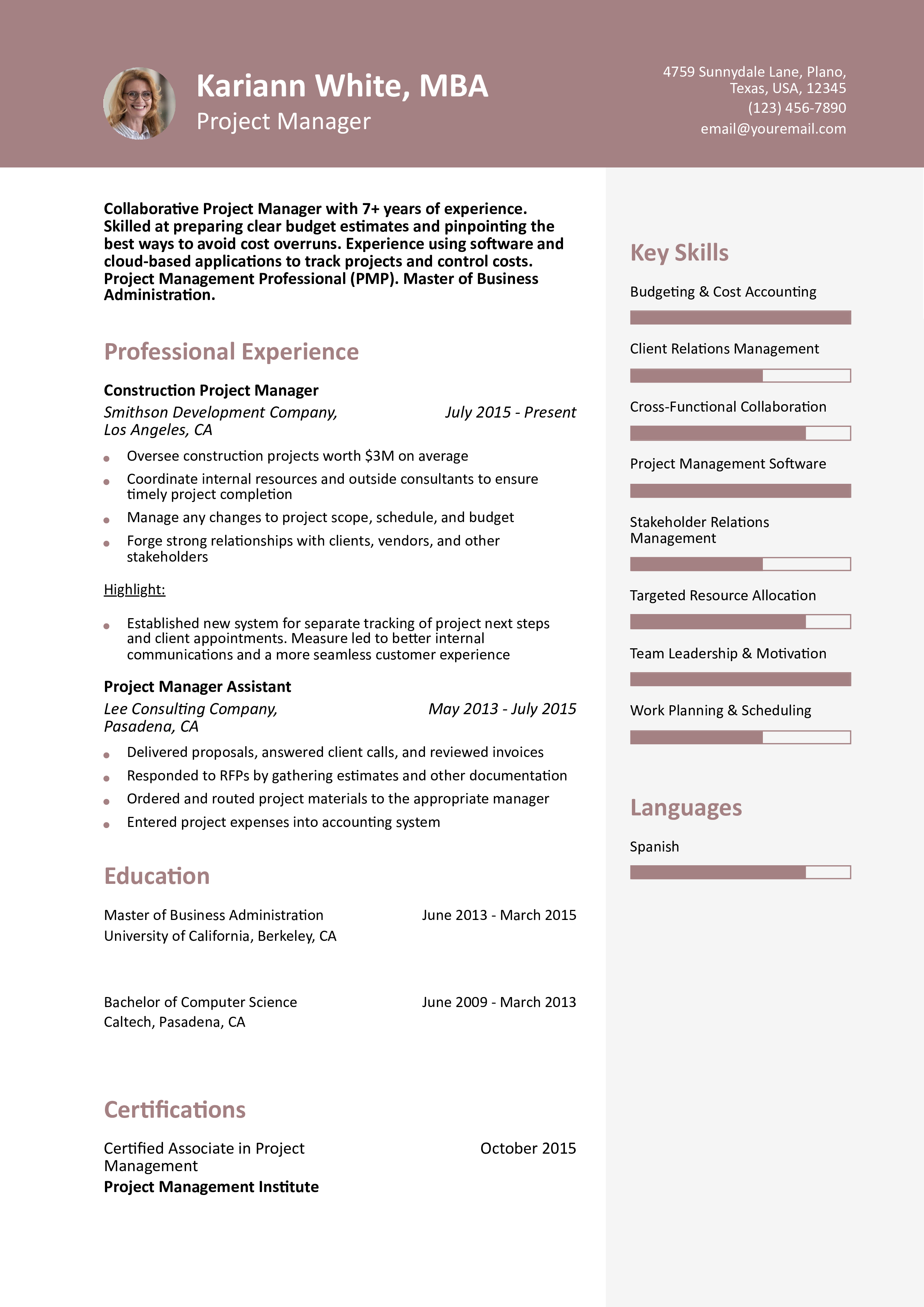How To Write a General Resume
If your job search is fairly open-ended, you may wish to create a general resume to use for many opportunities. But the danger of this approach is it can make your resume not just broad but unfocused. When a resume doesn’t focus on employers’ hiring needs, it usually fails to persuade them to call you for an interview. Learn how to make a resume that suits various job roles.
You don’t need a crystal-clear idea of your target job to write a focused and effective “general” resume. In fact, you don’t need to know your target industry, company size, or even job title. But do identify two or three core strengths (such as customer relations or talent retention) you want to apply in your next position. With those strengths established, you can give your resume the focus it needs while keeping your overall presentation broad enough to find jobs in many areas.
The following tips and examples will show you how to highlight your core strengths in each section of your resume so it gets you interviews for your next job.
- Entry-Level
- Mid-Career
- Senior-Level

1. Write a brief summary of your general qualifications
In a brief paragraph or bulleted list at the top of your resume, catch hiring managers’ attention by giving three to five key reasons you can excel in your target work areas. These reasons may include your general work style, years of experience, a signature achievement, or an advanced degree or certification. (Note, most job seekers find it easier to write their profile last.)
Refer to these resume summary examples to craft a concise and effective introduction. Resume Builder offers free resume templates designed by HR experts and you can choose from professional resume templates tailored for all career levels.
Entry-Level Profile Example
Sales Consultant with 3+ years of retail experience. Foster strong revenue growth and repeat business by providing top-quality service experiences. Highly attuned to the unique needs and requests of each customer. Bilingual: Fluent in English and Spanish.
Mid-Career Profile Example
Collaborative Project Manager with 7+ years of experience. Skilled at preparing clear budget estimates and pinpointing best ways to avoid cost overruns. Experience using software and cloud-based applications to track projects and control costs. Project Management Professional (PMP). Master of Business Administration.
2. Outline your general experience in a compelling list
Use the experience section to give examples of your success in your target work areas – this helps hiring managers see how you’d apply your strengths and add value to their organization.
For each job in your recent work history, brainstorm your duties and achievements on a separate document or sheet of paper. Then, identify and copy the most relevant details into your resume. You can do this by reviewing your notes one by one, always addressing the same question: Does this overlap with the kind of work you’d like to do in your next job? If yes, copy it in. If not, leave it out. Don’t worry if this method causes you to omit a lot of work information. The point here isn’t to give a comprehensive account of your experience but a focused one relating to the core strengths you’ve identified.
Also, consider omitting product- or industry-specific details from your work history. This helps lift your related experience out of its original work setting, so it can speak to various others. For instance, say you’re targeting sales jobs and are open to working in a different market or industry. By leaving out details on the products you sell, you can avoid getting pigeonholed and keep attention on the transferable sales skills you’ve gained.
Mid-Career Professional Experience Example
Construction Project Manager, Smithson Development Company, Los Angeles, CA | July 2015 to Present
- Oversee construction projects worth $3M on average
- Coordinate internal resources and outside consultants to ensure timely project completion
- Manage any changes to project scope, schedule, and budget
- Forge strong relationships with clients, vendors, and other stakeholders
Highlight:
- Established new system for separate tracking of project next steps and client appointments. Measure led to better internal communications and a more seamless customer experience
Senior-Level Professional Experience Example
Senior Auditor, PMG International, New York, NY | December 2012 to Present
- Develop audit programs to carefully assess risks and legal requirements for key organization activities
- Write and present regular audit reports to senior management
- Plan yearly audits for domestic and international office locations
Highlight:
- Streamlined the internal audit process, cutting yearly costs by $95K
3. Add general education and certifications
View the education and certifications sections as a chance to show your relevant knowledge base. Consider including details like your college major, minor, or coursework if they relate to the core strengths you’d like to apply in your next job. In addition, you could give a brief description of any relevant but lesser-known certifications or training programs you’ve done and would now like to draw on.
For specific tips, see how to list your education on a resume.
Below are resume templates and examples to help you format your education and certification details. Note, optional resume template areas appear in [brackets].
Education
Template:
Degree Name — [Major, Minor], School Name, City, ST or online | [Year]
[#.# GPA] | [Academic Honors]
[Select Coursework]
Example:
Master of Business Administration, University of California, Berkeley | 2015
Certification
Template:
Certification Name or Title, [Awarding Organization] | [Year]
[Description]
Example:
Certified Associate in Project Management, Project Management Institute | 2015
4. List key general skills and proficiencies
Add a key skills section to show the different ways you can contribute to your target job. Aim for variety, covering both hard and soft skills, as well as any technical programs you’re versed in and would like to use.
For guidance on relevant skills to include, explore these resume skills examples.
Below are some common skills and keywords to consider for this section of your resume:
| Key Skills and Proficiencies | |
|---|---|
| Business needs assessment | Client satisfaction and retention |
| Cost reduction and elimination | Cross-functional collaboration |
| Efficiency improvement | Inventory management |
| Lean manufacturing | Market strategy development |
| Microsoft Office Suite | Process streamlining |
| Project and program management | Quality assurance |
| Reporting and documentation | Revenue and profit growth |
| Risk management and mitigation | Salesforce.com |
| Staff training and development | Stakeholder relations |
| Strategic business development | Talent hiring and retention |
| Task prioritization | Team leadership and motivation |
| Time management | Vendor contract negotiations |
How To Pick the Best General Resume Template
For most job seekers, a clear and straightforward resume template is best. Opt for a layout that lets the hiring manager quickly review your best career details. Select a traditional resume font, and avoid any template with a colorful or elaborate design. Also, ensure the template complies with applicant tracking systems (ATS) used by employers to screen resumes.
Explore our collection of free resume templates to kickstart your job search. Discover the best resume formats to create a professional and ATS-friendly layout. Opt for professional resume templates that align with hiring managers’ expectations. For a unique approach, select a creative resume template.
General Text-Only Resume Templates and Examples
Kariann White, MBA
(123) 456-7890 | [email protected] | Pasadena, CA 12345 | www.linkedin.com/example
Collaborative Project Manager with 7+ years of experience. Skilled at preparing clear budget estimates and pinpointing best ways to avoid cost overruns. Experience using software and cloud-based applications to track projects and control costs. Project Management Professional (PMP). Master of Business Administration.
Key Skills- Budgeting & Cost Accounting
- Client Relations Management
- Cross-Functional Collaboration
- Project Management Software
- Stakeholder Relations Management
- Targeted Resource Allocation
- Team Leadership & Motivation
- Work Planning & Scheduling
Construction Project Manager, Smithson Development Company, Los Angeles, CA | July 2015 to Present
- Oversee construction projects worth $3M on average
- Coordinate internal resources and outside consultants to ensure timely project completion
- Manage any changes to project scope, schedule, and budget
- Forge strong relationships with clients, vendors, and other stakeholders
Highlight:
- Established new system for separate tracking of project next steps and client appointments. Measure led to better internal communications and a more seamless customer experience
Project Manager Assistant, Lee Consulting Company, Pasadena, CA | May 2013 to July 2015
- Delivered proposals, answered client calls, and reviewed invoices
- Responded to RFPs by gathering estimates and other documentation
- Ordered and routed project materials to the appropriate manager
- Entered project expenses into accounting system
Master of Business Administration, University of California, Berkeley | 2015
Bachelor of Computer Science, Caltech Pasadena, CA | 2013
CertificationCertified Associate in Project Management, Project Management Institute | 2015
LanguageFluency in Spanish
Frequently Asked Questions: General Resume Examples and Advice
What are common action verbs for general resumes? -
One of the best ways to enhance your resume is by starting each bullet point with a strong verb. Action verbs keep the hiring manager’s attention and show the dynamic nature of your experience. The following list can help you find a good mix of action verbs for your resume:
| Action Verbs | |
|---|---|
| Automated | Averted |
| Coordinated | Created |
| Decreased | Developed |
| Eliminated | Enhanced |
| Expedited | Garnered |
| Generated | Improved |
| Increased | Introduced |
| Launched | Lowered |
| Organized | Prevented |
| Produced | Raised |
| Ranked | Shortened |
| Streamlined | Strengthened |
| Updated | Won |
How do you align your general resume with a job posting?-
First, look closely at the job post text and highlight words that are repeated, emphasized, or otherwise seem important. Compare these highlighted phrases to the language you’re using in your resume, particularly the profile and key skills sections. Then seek ways to align your resume language with the job post while not copying phrases or misstating your background.
For example, if the company seeks someone collaborative, emphasize that aspect of your experience in your profile with a line like “Thrive in collaborative work settings.” Or say the company has many non-English speaking customers. Focus on your foreign language skills both in your profile and as a separate section farther down the document.
Also, consider adding brief descriptions of the places you’ve worked in [brackets] right next to or below the company name. Company descriptions let you show any similarities between your past employers and the one who posted the job. For example, maybe you’ve worked for companies of a similar size or industry. Or maybe you’ve worked at organizations with an aligned mission or leadership philosophy. By weaving these details into your descriptions, you can make your resume more relevant to the job opening at hand.
What is the best general resume format?-
Most job seekers should use the combination (or hybrid) format. True to its name, this format combines two important features of other resume formats: the chronological format’s experience section and the functional format’s profile section. (The resume examples on this page all use a combination format.)
By fusing these two features, a combination resume offers the best of both worlds. The experience section lets you outline your recent work history – essential information for most employers. At the same time, the profile section lets you display your career highlights at the top, regardless if they’re from that work history or another part of your background. As a result, you can present yourself clearly and strategically. With this format, you give hiring managers the best view of your experience and relevant strengths, so they can make an informed decision to call you for an interview.

Craft your perfect resume in minutes
Get 2x more interviews with Resume Builder. Access Pro Plan features for a limited time!








